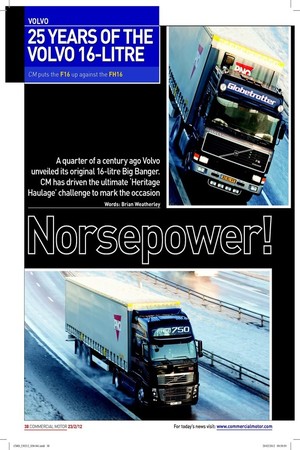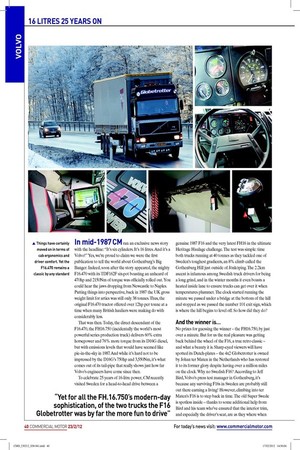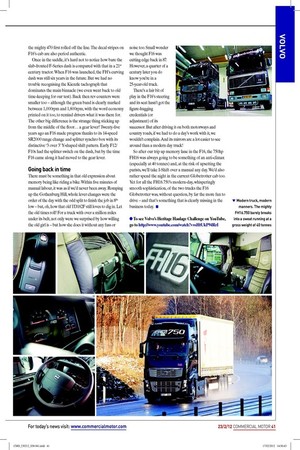25 YEARS OF THE
Page 31

Page 33

Page 34

If you've noticed an error in this article please click here to report it so we can fix it.
VOLVO 16-LITRE
CM puts the F16 up against the FH16
A quarter of a century ago Volvo unveiled its original 16-litre Big Banger. CM has driven the ultimate ‘Heritage Haulage’ challenge to mark the occasion
Words: Brian Weatherley
In mid-1987 CM ran an exclusive news story with the headline: “It’s six cylinders. It’s 16 litres. And it’s a Volvo!” Yes, we’re proud to claim we were the irst publication to tell the world about Gothenburg’s Big Banger. Indeed, soon after the story appeared, the mighty F16.470 with its TDF162F six-pot boasting an unheard of 470hp and 2150Nm of torque was oficially rolled out. You could hear the jaws dropping from Newcastle to Naples. Putting things into perspective, back in 1987 the UK gross weight limit for artics was still only 38 tonnes. Thus, the original F16.470 tractor offered over 12hp per tonne at a time when many British hauliers were making do with considerably less.
That was then. Today, the direct descendant of the F16.470, the FH16.750 (incidentally the world’s most powerful series production truck) delivers 60% extra horsepower and 76% more torque from its D16G diesel, but with emissions levels that would have seemed like pie-in-the-sky in 1987. And while it’s hard not to be impressed by the D16G’s 750hp and 3,550Nm, it’s what comes out of its tail-pipe that really shows just how far Volvo’s engineers have come since then.
To celebrate 25 years of 16-litre power, CM recently visited Sweden for a head-to-head drive between a genuine 1987 F16 and the very latest FH16 in the ultimate Heritage Haulage challenge. The test was simple: time both trucks running at 40 tonnes as they tackled one of Sweden’s toughest gradients, an 8% climb called the Gothenburg Hill just outside of Jönköping. The 2.2km ascent is infamous among Swedish truck drivers for being a long grind, and in the winter months it even boasts a heated inside lane to ensure trucks can get over it when temperatures plummet. The clock started running the minute we passed under a bridge at the bottom of the hill and stopped as we passed the number 101 exit sign, which is where the hill begins to level off. So how did they do?
And the winner is...
No prizes for guessing the winner – the FH16.750, by just over a minute. But for us the real pleasure was getting back behind the wheel of the F16, a true retro classic – and what a beauty it is. Sharp-eyed viewers will have spotted its Dutch-plates – the 4x2 Globetrotter is owned by Johan ter Maten in the Netherlands who has restored it to its former glory despite having over a million miles on the clock. Why no Swedish F16? According to Jeff Bird, Volvo’s press test manager in Gothenburg, it’s because any surviving F16s in Sweden are probably still out there earning a living! However, climbing into ter Maten’s F16 is to step back in time. The old Super Swede is spotless inside – thanks to some additional help from Bird and his team who’ve ensured that the interior trim, and especially the driver’s seat, are as they where when the mighty 470 irst rolled off the line. The decal stripes on F16’s cab are also period authentic.
Once in the saddle, it’s hard not to notice how bare the slab-fronted F-Series dash is compared with that in a 21st century tractor. When F16 was launched, the FH’s curving dash was still six years in the future. But we had no trouble recognising the Kienzle tachograph that dominates the main binnacle (we even went back to old time-keeping for our test). Back then rev counters were smaller too – although the green band is clearly marked between 1,000rpm and 1,600rpm, with the word economy printed on it too, to remind drivers what it was there for. The other big difference is the strange thing sticking up from the middle of the loor... a gear lever! Twenty-ive years ago an F16 made progress thanks to its 14-speed SR2000 range change and splitter synchro box with its distinctive ‘3 over 3’ Y-shaped shift pattern. Early F12/ F10s had the splitter switch on the dash, but by the time F16 came along it had moved to the gear lever.
Going back in time
There must be something in that old expression about memory being like riding a bike. Within ive minutes of manual labour, it was as if we’d never been away. Romping up the Gothenburg Hill, whole lever changes were the order of the day with the odd split to inish the job in 8th low – but, oh, how that old TD162F still loves to dig in. Let the old times roll! For a truck with over a million miles under its belt, not only were we surprised by how willing the old girl is – but how she does it without any fuss or
noise too. Small wonder we thought F16 was cutting edge back in 87. However, a quarter of a century later you do know you’re in a 25-year-old truck.
There’s a fair bit of play in the F16’s steering and its seat hasn’t got the igure-hugging credentials (or adjustment) of its successor. But after driving it on both motorways and country roads, if we had to do a day’s work with it, we wouldn’t complain. And its mirrors are a lot easier to see around than a modern day truck!
So after our trip up memory lane in the F16, the 750hp FH16 was always going to be something of an anti-climax (especially at 40 tonnes) and, at the risk of upsetting the purists, we’ll take I-Shift over a manual any day. We’d also rather spend the night in the current Globetrotter cab too. Yet for all the FH16.750’s modern-day, whisperingly smooth sophistication, of the two trucks the F16 Globetrotter was, without question, by far the more fun to drive – and that’s something that is clearly missing in the business today. ■
● To see Volvo’s Heritage Haulage Challenge on YouTube, go to http://www.youtube.com/watch?v=sHtUkP94RrI












































